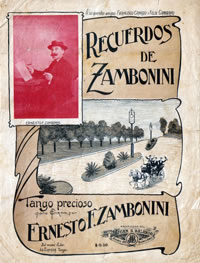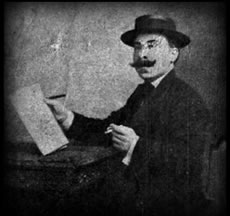By
Chronicle of a cut and a tango, “Recuerdos de Zambonini”

hey say that it happened by the Centennial, maybe a couple of years later, at a café with waitresses in the neighborhood of La Boca. A man around thirty years old, known as El Rengo, with the blade of his knife cut deeply the face of a boy, Roberto Firpo, who was then respectfully called Don Roberto. The reasons for that violent attack were only known by the witnesses who kept an honorable silence.
 Also it was known that, not fully satisfied with the aggression, the assailant went home and, immediately, added the music notes that were missing in a music staff and, with a steady slowness, he wrote letter by letter the words of the title of a tango: “Recuerdos de Zambonini”, in allusion to the cut made and using his own surname so that everybody would know about the event. A good choice that was not foreseen because the title long lasted and the melody soon was forgotten.
Also it was known that, not fully satisfied with the aggression, the assailant went home and, immediately, added the music notes that were missing in a music staff and, with a steady slowness, he wrote letter by letter the words of the title of a tango: “Recuerdos de Zambonini”, in allusion to the cut made and using his own surname so that everybody would know about the event. A good choice that was not foreseen because the title long lasted and the melody soon was forgotten.
The assaulted one did not pay much attention to the incident and only said that he had been treacherously wounded. But he went further, he also wrote a tango, “Mal pegador”, which was unimportant in comparison with his later oeuvre. And here as far as we know it was all finished.
As for Don Roberto, is much what we know of him as a fundamental character of tango. As for El Rengo Ernesto Zambonini, very little. Below we include some sketches about his career in our music.
He was born in 1880 and died on April 23, 1947 when he ha already quit tango. He was violinist in groups of that time. We can recall his tenure with Vicente Greco, with a trio along with Eduardo Arolas and Rafael Tuegols, in the Firpo’s orchestra, in the one led by Tano Genaro (with Juan Carlos Cobián on piano), with Manuel Aróztegui and in other forgotten aggregations.
Francisco Canaro who did not use to speak badly of his old pals, and to whom Zambonini, together with Félix Camurano, dedicated the tango, did not refrained himself of describing negatively his personality: «He had the habit of getting drunk and when he was in that state he became an impertinent man and an extremely aggressive person» and his words are quoted because among his stories one that took place in La Boca is mentioned. An orchestra of Italian players was playing at a venue and for some reason, probably alcoholic drinks, he forced them to play for hours only his tango “La clavada”. We guess that the imposition may have been due to a convincing menace.
 We can’t say it for certain but also “La clavada”, because of its suggestive title, we think would have something to do with that episode, a permanent obsession of the composer until the end of his days. Notwithstanding this the drawing appearing on the sheetmusic cover portrays some peasants playing a country game. Nor in the original publication of “Recuerdos de Zambonini” does the drawing allude to the aggression but it shows a carriage pulled by horses with four fun-loving people.
We can’t say it for certain but also “La clavada”, because of its suggestive title, we think would have something to do with that episode, a permanent obsession of the composer until the end of his days. Notwithstanding this the drawing appearing on the sheetmusic cover portrays some peasants playing a country game. Nor in the original publication of “Recuerdos de Zambonini” does the drawing allude to the aggression but it shows a carriage pulled by horses with four fun-loving people.
Of his short life nearly nothing is known; as for his appearance it is interesting the brief description made by León Benarós:
«I was a young attorney working in a court in San Martín where the novelist Miguel Angel Speroni was judge in civil matters. The latter asked me:
—D’you know who’s always in the barroom across the street?... Zambonini.
—The one who wrote “La clavada”?, I asked.
—Exactly.
—This is more important than this succession —I added and crossed the street towards the bar—. And there he was, sitting at a little table with a glass of white wine. He thanked my praise for the mentioned tango and after some more glasses of wine he became somewhat talkative.
—D’you know I cut Firpo’s face under his chin? I was in jail. While in prison people belonging to a music publishing house came and made me sign a paper. I thought it was an authorization to publish the piece but it turned out it was a assignment of royalties. Fortunately when I got out I managed to settle the issue.
He was a short man, rough and what was funny is that he was wearing an undershirt with no shirt on and he had his trousers fastened with a piece of wire».
This few reports bring us a profile of the character. However he kept a close friendship with a man that can be placed due to culture, refinement and even, financial situation, in a place diametrically opposite to his: Carlos Posadas. To such an extent that he was one of the few that stayed by his bedside when he got ill and almost the only one that accompanied his remains.
As musician he was regarded, together with Ernesto Ponzio, as the creator of the canyengue beat with the violin, like Prudencio Aragón was for the piano and Leopoldo Thompson for the double bass.
He composed and published around thirty numbers. We shall name only: “La calesita [c]” that Canaro recorded in 1924; “María Barrientos” that evokes the renowned operatic female singer; “Recuerdos de Zambonini”, reason for this chronicle, was recorded by Tano Genaro in 1913 and in whose sheetmusic published by Juan Balerio we can see the only photograph known of Zambonini (with straw hat, cigarette and pencil) and on which with a perverse irony it is labeled the piece as a «Tango precioso». Lastly “La clavada”, dedicated to Carlos Posadas, Juan Bergamino and Feliciano Herrera was recorded by Greco in 1913, Canaro in 1930, Fresedo in 1933, Juan D'Arienzo in 1940 and 1967, and Horacio Salgán in 1950 and 1964, among others. This was, no doubt, his everlasting tango.